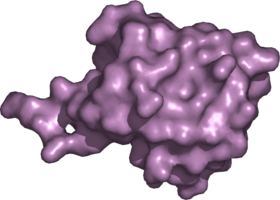Ubiquitin
|
|
Ubiquitin is a small protein that occurs in most eukaryotic cells. Its main function is to mark other proteins for destruction, known as proteolysis. Several ubiquitin molecules attach to the condemned protein (polyubiquitination), and it then moves to a proteasome, a barrel-shaped structure where the proteolysis occurs. Ubiquitin can also mark transmembrane proteins (for example, receptors) for removal from the membrane.
Ubiquitin consists of 76 amino acids and has a molecular mass of about 8500 amu. It is highly conserved among eukaryotic species: Human and yeast ubiquitin share 96% sequence identity.
Ubiquitin_cartoon.png
The process of marking a protein with ubiquitin consists of a series of steps:
- Activation of ubiquitin -- the carboxyl group of the terminal glycine of ubiquitin binds to the sulfhydryl group -SH of an ubiquitin-activating enzyme E1. The sulfhydryl group is a cysteine residue on the E1 protein. This step requires a ATP molecule as an energy source and results in the formation of a thioester bond between ubiquitin and E1.
- Transfer of ubiquitin from E1 to the ubiquitin-conjugating enzyme E2 via trans(thio)esterification.
- Then, the final transfer of ubiquitin to the target protein can occur either:
- directly from E2. This is primarily used when ubiquitin is transferred to another ubiquitin already in place, creating a branched ubiquitin chain.
- or
- via an E3 enzyme, which binds specifically to both E2 and the target protein. The target protein is usually a damaged or non-functional protein that is recognized by a destruction-targeting sequence. Ubiquitins then bind to a lysine residue in the target protein, eventually forming a tail of ubiquitin molecules. This is the typical way to mark specific proteins for proteolysis.
- directly from E2. This is primarily used when ubiquitin is transferred to another ubiquitin already in place, creating a branched ubiquitin chain.
Finally, the marked protein is digested in the 26S-proteasome into small peptides, amino acids (usually 6-7 aa subunits). Although the ubiquitins also enter the proteasome, they are not degraded and may be used again.
The gene whose disruption causes Angelman syndrome, UBE3A, encodes an ubiquitin ligase (E3) enzyme termed E6-AP.
The ubiquitin pathway is thought to be the method of cellular egress for a number of retroviruses, including HIV and Ebola, but the exact mechanism by which this occurs has yet to be deduced.
The discovery of the role of ubiquitin in the proteolytic pathway earned Aaron Ciechanover, Avram Hershko and Irwin Rose the 2004 Nobel Prize in Chemistry.
Immunohistochemistry
Antibodies to ubiquitin are used in histology to identify abnormal accumulations of protein inside cells that are markers of disease. These accumulations are called inclusion bodies. Examples of such abnormal inclusions in cells are
- Neurofibrillary tangles in Alzheimer's disease
- Lewy body in Parkinson's disease
- Pick bodies in Picks disease
- Inclusions in motor neuron disease
- Mallory's Hyalin in alcoholic liver disease
- Rosenthal fibres in astrocytes
External links
- Ubiquitin (http://www.chem.uni.wroc.pl/jaremko/ubiquitin.htm), Molecule of the Month (http://www.chm.bris.ac.uk/motm/motm.htm).de:Ubiquitin
eo:Ubikvitino he:אוביקוויטין zh-min-nan:Ubiquitin ja:ユビキチン pl:Ubikwityna zh:泛素

